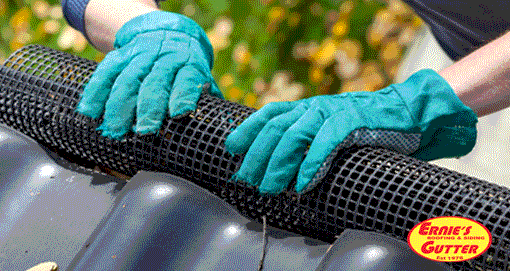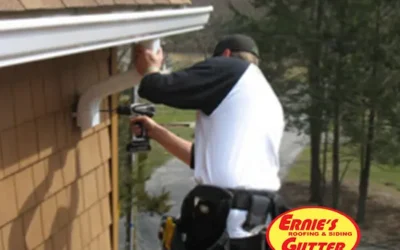Guide to Gutter Guards: Pros, Cons, and Expert Recommendations for Denver Homeowners
Gutter Guards: Pros, Cons, and Expert Recommendations
Ernie’s Gutter is a third-generation, family-owned business based in Denver, Colorado, providing top-quality gutter and roofing services since 1978. With over 45 years of experience, we specialize in seamless gutters, gutter repair, roof installation, roof repair, and water drainage solutions. We are your trusted roofing contractor in Denver—serving the area since 1978. We specialize in gutter replacement, roof installation, and roof repairs. Contact us at 720-346-ROOF or visit https://erniesgutter.com/ for more information.
Table of Contents

Why Gutter Guards Matter for Denver Homes
Denver’s unique weather—sunny days, sudden hail storms, heavy spring rains, and abundant pine needles—puts extra strain on your water-collection system. Gutters filled with debris can:
-
Overflow, causing water to damage fascia, siding, and landscaping
-
Clog downspouts, leading to foundation erosion and basement flooding
-
Become breeding grounds for mosquitoes and mold
A properly installed and well-maintained gutter guard helps ensure your seamless gutter system performs at peak efficiency, protecting your home’s structural integrity and boosting curb appeal.
Common Gutter Guard Problems in Colorado
-
Granule Buildup
-
Asphalt shingle granules wash into gutters, settling atop guards
-
Over time, granule deposits can block water flow
-
-
Pine Needles and Leaves
-
Denver’s trees—especially pines and aspens—drop needles and foliage
-
Debris can wedge into poorly designed mesh or hole patterns
-
-
Ice Damming
-
Winter freeze-thaw cycles form ice dams at gutter edges
-
Ice can lift or puncture flimsy guards
-
-
Wind and Hail Damage
-
High-velocity gusts dislodge plastic guards
-
Hail dents thin-gauge metal screens
-
By understanding these local challenges, you can choose a gutter guard design that holds up in Denver’s varied climate.
Types of Gutter Guards
Micromesh Gutter Guards
Overview: Fine stainless-steel or aluminum mesh that filters out debris while allowing water through.
Pros:
-
Blocks even tiny particles (shingle grit, pine pollen)
-
Durable metal construction resists rust and corrosion
-
Low profile for seamless curb appeal
Cons:
-
More expensive per linear foot
-
Installation can be tricky without proper fascia anchoring
-
Requires occasional cleaning of mesh surface
Ernie’s Recommendation: Look for micromesh systems with both front lip and rear screw-down capability. Anchoring to the fascia creates a rigid, long-lasting assembly.
Metal Covers with Front Lip
Overview: Stamped metal panels that hook over the front of the gutter and sit under the shingles.
Pros:
-
Affordable DIY option
-
Easy to cut and fit around corners
-
Good initial water flow performance
Cons:
-
Front-only attachment can loosen; may blow off in storms
-
Larger perforations permit granule and small-leaf intrusion
-
Metal gauge varies widely; thin panels dent easily
Ernie’s Insight: Choose guards with a deeper rear flange to allow optional back-screwing for reinforcement.
Perforated/Hole-Style Guards
Overview: Panels or strips with punched holes to let water in while blocking large debris.
Pros:
-
Economical and widely available
-
Simple design—minimal surface area to clog
Cons:
-
Holes often too large for pine needles and fine debris
-
Debris can wedge in holes, requiring manual cleaning
-
No rear anchoring leads to sagging between brackets
Pro Tip: Space guards on 12-inch centers and consider adding extra hangers when installing over heavy foliage.
Plastic Gutter Guards
Overview: Injection-molded plastic inserts or snap-on covers.
Pros:
-
Lowest upfront cost
-
Easy for homeowners to install by hand
Cons:
-
Plastic becomes brittle over time; UV exposure accelerates cracking
-
Flexible design fails under weight of leaves, snow, or ice
-
Many plastic meshes lack sufficient opening geometry, causing water to sheet over
Ernie’s Warning: Avoid any gutter guard made entirely of plastic—cheap upfront but high long-term cost in repairs and replacements.
Sponge-Based Gutter Inserts
Overview: Foam or “sponge” strips that sit inside the gutter to trap debris.
Pros:
-
Very cheap and quick to install
-
Initial water retention helps filter out leaves
Cons:
-
Sponge soaks up moisture, fostering mold and rot
-
Debris sticks to the foam; blocks quickly
-
Ineffective within months—most end up removed and replaced
Ernie’s Verdict: “Worst product category”—sponge inserts turn into debris magnets, causing more problems than they solve.
Premium Brand Systems
Overview: Patented systems (e.g., micromesh with integrated aluminum frames, specialized domes, or tension-fit designs).
Pros:
-
Backed by robust warranties (often 20+ years)
-
Field-tested in varied climates
-
Engineered to maintain water flow while shedding debris
Cons:
-
Up to 10× the cost of big-box offerings
-
Often require professional installation
-
Some brands aggressively upsell add-ons like heat cables
Ernie’s Tip: If budget allows, invest in a reputable brand with proven performance. Always read warranty fine print—look for “no clog guarantee.”
Big-Box Store Comparisons: Lowe’s, Home Depot, Menards
| Feature | Lowe’s | Home Depot | Menards |
|---|---|---|---|
| Micromesh Options | ✔️ Mid-grade stainless | ✔️ Aluminum & steel | ✔️ Limited selection |
| Metal Lip Covers | ✔️ Multiple price tiers | ✔️ Variety of gauges | ✔️ Fewer heavy-gauge pieces |
| Hole-Style Panels | ✔️ Economy & premium | ✔️ Wider hole options | ✔️ Contractor lines |
| Plastic Guards | ✔️ Budget packs | ✔️ Snap-on kits | ✔️ Bulk rolls |
| Sponge Inserts | ✔️ Single brand only | ✔️ 2-3 manufacturers | ✔️ Generic foam strips |
-
Performance Ranking (Best to Worst):
-
Micromesh (all three)
-
Metal covers with lip (all three)
-
Perforated panels (Menards contractor line alone)
-
Plastic snap-ons
-
Foam inserts
-
The Truth About Gutter Guard Performance
Despite marketing claims, 95% of gutter guards eventually fail in Denver’s environment. Here’s why:
-
Incomplete Debris Exclusion: Tiny particles—asphalt granules, pollen, pine needles—find their way through most meshes and perforations.
-
Attachment Weakness: Guards that only hook or rest on the front edge loosen over time; wind and ice pry them free.
-
Maintenance Neglect: Even top-tier guards require periodic clearing of surface debris to prevent overflow.
-
Structural Movement: Roofs and gutters shift with temperature cycles; rigid plastic guards crack or warp.
At Ernie’s Gutter, we’ve witnessed every failure mode: clogged micromesh, ripped covers, foam disintegration, and perforated panels tearing under branch impact. The only way to maximize performance is proper design, correct installation, and ongoing maintenance—not simply buying the cheapest option.
How to Choose the Right Gutter Guard for Your Home
-
Assess Your Debris Load
-
Heavy pine needle areas → choose fine-mesh stainless steel
-
Leafstorm-prone zones → look for a sloped, kickout design
-
-
Consider Local Climate
-
Freeze–thaw cycles → avoid plastics; metal guards hold ice better
-
Hail frequency → use thick-gauge aluminum or steel
-
-
Installation Method
-
Rear screw-down potential adds rigidity
-
Front-only hook designs are faster but less durable
-
-
Budget vs. Longevity
-
DIY plastic guards: lowest cost, highest risk of premature failure
-
Professional micromesh: highest cost, decades of near-zero maintenance
-
-
Warranty Fine Print
-
Ensure “no-clog” and “wind-guarantee” clauses cover the real risks
-
Beware of pro-rated warranties that drop off after 5 years
-
DIY vs. Professional Installation
| Aspect | DIY | Professional (Ernie’s Gutter) |
|---|---|---|
| Time Investment | 1–2 weekends, depending on experience | 1 day for a 2,000 ft² home |
| Tools Required | Ladder, tin snips, drill, ladder stabilizer | Full safety harness, pneumatic fasteners, specialized tools |
| Attachment Quality | Front lip only on most guards | Rear-and-front anchoring for maximum rigidity |
| Warranty Validity | May void if not installed per manufacturer specs | Manufacturer–approved installers preserve full warranty |
| Long-Term Cost | Potential repeated repairs | Single investment covers decades |
At Ernie’s Gutter, our certified installers ensure your gutter guard system is fastened to both the fascia and gutter front, giving you reliable, long-lasting protection.
Maintenance Tips for Long-Lasting Protection
-
Biannual Inspections
-
Spring (post-pine pollen) and fall (leaf drop)
-
-
Surface Debris Removal
-
Use a soft-bristle brush and garden hose
-
-
Check Fasteners
-
Retighten or replace any loose screws or clips
-
-
Downspout Screening
-
Install a gutter strainer or leaf-catcher basket at each downspout
-
-
Ice-Dam Prevention
-
Apply heat cables along vulnerable roof-edge zones
-
Regular upkeep extends the life of any gutter guard—DIY or pro-installed.
Case Studies: Denver Installations by Ernie’s Gutter
-
Stapleton Bungalow
-
Issue: Clogged pine needles and ice dams
-
Solution: Stainless-steel micromesh with fascia-screw anchors
-
Result: 3 years of maintenance-free operation, no ice buildup
-
-
City Park Townhome
-
Issue: Granule wash from older shingles blocking perforated panels
-
Solution: Upgraded metal cover with smaller holes + downspout strainers
-
Result: Clear water flow, zero blockages in 18 months
-
-
Aurora Ranch Home
-
Issue: Budget plastic guards splitting under hail impact
-
Solution: Heavy-gauge aluminum micro-perforated covers
-
Result: Zero damage after two hailstorms, pleased homeowner testimonial
-
Cost Analysis and Return on Investment
| Guard Type | Material Cost (ft) | Installation Cost (ft) | Total First Year Cost (ft) | Expected Lifespan | Cost per Year (ft) |
|---|---|---|---|---|---|
| Plastic Snap-On | $1.50 | $0.50 (DIY) | $2.00 | 3 years | $0.67 |
| Perforated Metal | $3.00 | $1.00 (DIY) | $4.00 | 5 years | $0.80 |
| Mid-Grade Dealer Micromesh | $6.00 | $2.00 (DIY) | $8.00 | 7 years | $1.14 |
| Pro-Installed Premium | $12.00 | $8.00 | $20.00 | 20 years | $1.00 |
-
Key Insight: Although premium systems have a higher upfront cost, their extended lifespan and reduced maintenance often yield the lowest cost per year.
Frequently Asked Questions
-
What is the best gutter guard for Denver homes?
-
Fine-mesh stainless steel guards that can be anchored front and back
-
Thick-gauge aluminum with powder coating for hail resistance
-
Systems backed by a “no-clog guarantee”
-
-
Can I install gutter guards myself?
-
Yes, but only with basic tools; however, improper attachment voids many warranties
-
Professional installation ensures fascia anchoring and proper pitch
-
DIY may save on labor but incur greater long-term maintenance
-
-
Do gutter guards eliminate all cleaning?
-
No system is 100% maintenance-free; surface cleaning twice a year is recommended
-
Downspout strainers help catch passing debris when guards fail
-
Regular inspections prevent worst-case blockages
-
-
How do gutter guards perform in hail or snow?
-
Metal guards resist hail dents better than plastic
-
Mesh designs shed snow, reducing ice-dam formation
-
Some premium brands offer integrated heat-cable channels
-
-
Will a gutter guard prevent ice dams?
-
Indirectly: by keeping gutters clear, water drains smoothly before freezing
-
Heat-cable–compatible guards further guard against ice build-up
-
Proper attic insulation and ventilation remain key for ice-dam control
-
-
How much does gutter guard installation cost?
-
Plastic DIY kits: $0.50–$1.50/ft (materials only)
-
Professional metal panel installation: $5–$10/ft installed
-
Premium micromesh systems: $15–$25/ft installed
-
-
Do gutter guards void my roof warranty?
-
Only if improperly installed under shingles—always follow manufacturer guidelines
-
Professional installers typically work within roofing certifier specifications
-
Confirm with both roof and guard manufacturers before installation
-
-
How long do gutter guards last?
-
Plastic: 2–5 years before replacement
-
Perforated metal: 5–10 years depending on gauge
-
Micromesh stainless/steel: 15–25 years with proper attachment
-
-
What maintenance do gutter guards need?
-
Gentle surface brushing with a hose
-
Biannual inspections for loose fasteners
-
Downspout basket cleaning
-
-
Can gutter guards help prevent pests?
-
Yes—most guards block entry of birds, rodents, and large insects
-
Small openings still admit tiny pests; additional fine mesh may be needed
-
Keep overhanging branches trimmed to reduce pest access
Conclusion & Call to Action
Choosing the right gutter guard is crucial to protecting your Denver home from water damage, debris buildup, and ice dams. While big-box store options offer a variety of price points and designs, only a few combine durability, performance, and proper attachment methods. At Ernie’s Gutter, we recommend investing in a high-quality micromesh or heavy-gauge metal system—professionally installed with both front and rear anchoring—to ensure decades of trouble-free operation.
Protect your investment today! Contact Ernie’s Gutter at 720-346-ROOF or visit https://erniesgutter.com/ to schedule a free estimate. Let our third-generation experts install the best gutter protection for your home—backed by over 45 years of Denver service and satisfaction.
OUR SERVICES
Your Neighborhood Roofing Contractor
Get more information concerning our service, do not wait to call us at 720 346 ROOF today. We’ll be more than happy to schedule a meeting with you.
Residential Roofing Contractor
Ernie’s Roofing specialize in residential roofing in Denver and have a team of experienced professional Roofers available to help you get the job done right The First Time. From minor repairs and maintenance to full–scale roof replacements,

Commercial Roofing
We construct, repair, as well as maintain Commercial Roofing systems for services both large and also small, creating personalized services that conserve our client’s time, cash, and also power. Call us at 720 346 ROOF and book a consultation today.

Hail Damage
Their knowledgeable staff is ready to help you assess the damage caused by storms and provide you with a comprehensive repair evaluation & plan. We specialize in all types of roof damage, including hail, wind, and even lightning strikes. Hail Claim Help

INSURANCE CLAIMS HELP
Our team of experienced insurance claim specialists will work with you to ensure that the insurance claim process is as stress-free as possible. We will work with your insurance company to provide all necessary documentation and estimates to ensure that your claim is processed quickly and correctly.

Wind Damage
When it comes to roof damage, it can be difficult to determine whether the damage was caused by hail or wind. While both types of damage can cause similar symptoms, they have different causes and require different repair methods.
What’s New on The Blog
Downspout Repair: What Every Homeowner Needs to Know
Downspout RepairLatest News & Resources When you need a roof contractor you can rely on the team of experts at Ernie's Roofing. We specialize in a wide range of services from new construction, maintenance, and repairs for your home or business.Downspout Repair:...
Gutter Repair Denver 80211
Gutter Repair Denver 80211Latest News & Resources When you need a roof contractor you can rely on the team of experts at Ernie's Roofing. We specialize in a wide range of services from new construction, maintenance, and repairs for your home or business.Gutter...
Roof and Gutter Replacement Northglenn, CO
Roof and Gutter ReplacementLatest News & Resources When you need a roof contractor you can rely on the team of experts at Ernie's Roofing. We specialize in a wide range of services from new construction, maintenance, and repairs for your home or business.Roof and...
#1 Rated Roofing Contrator In Denver
Craftsmanship That Stands Like a House
Let’s Get Your Project on the Right Track

Let’s Get Started




